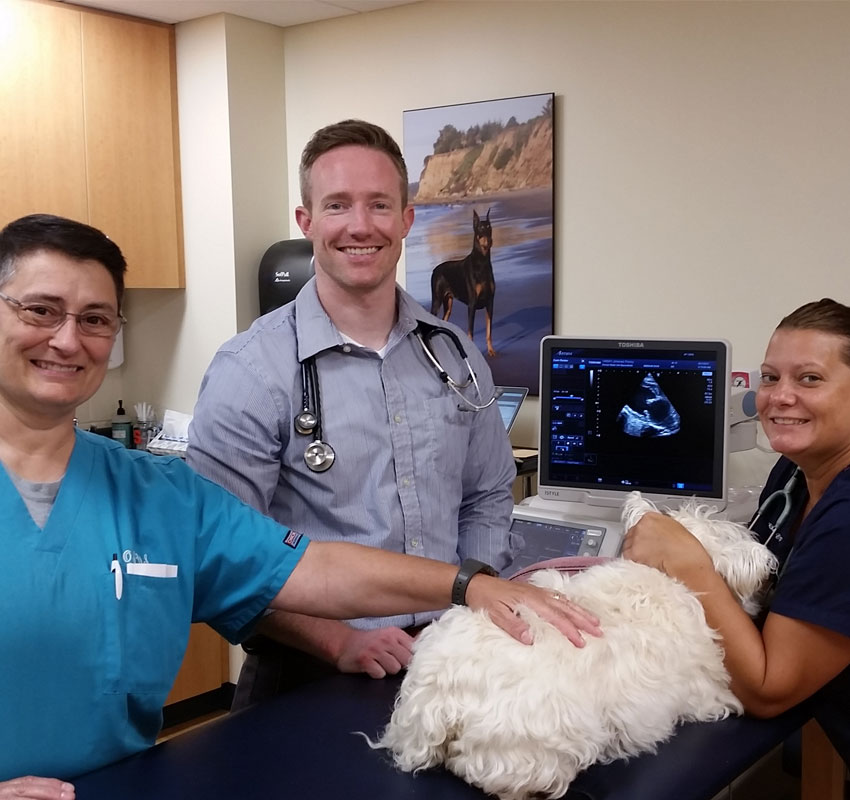How CT Scans For Animals Help Vets Detect Internal Issues Early}
Wiki Article
What You Need to Understand About Veterinary Services: An Overview of Diagnostic Devices and Procedures
Vet solutions play a crucial function in maintaining the health of pets. Normal check-ups can expose covert health and wellness concerns early on. Numerous analysis devices and procedures, such as blood tests and imaging methods, give necessary understandings right into an animal's health. Understanding these approaches is crucial for animal owners. What details diagnostic treatments are most frequently used, and exactly how can they influence a pet dog's treatment plan?Relevance of Routine Vet Exams
While numerous family pet owners may take too lightly the significance of routine veterinary check-ups, these consultations are crucial for maintaining a pet's total health and wellness. Regular sees to the vet permit early detection of potential health issues before they intensify right into severe troubles. Normal exams frequently consist of vaccinations, which are important for stopping infectious conditions that could drastically influence a pet dog's well-being. Additionally, these consultations give a chance for vets to evaluate the pet's weight, oral wellness, and overall problem, making sure that the animal is flourishing. During these brows through, pet owners can likewise get valuable advice on diet plan, workout, and preventive treatment customized to their details animal's requirements.Typical Diagnostic Procedures in Vet Medication
In veterinary medicine, exact diagnosis is vital for reliable therapy. Typical diagnostic procedures consist of blood testing techniques, advanced imaging modern technologies, and urinalysis, each playing a considerable duty in identifying health concerns. Recognizing these techniques improves the ability to provide proper take care of animal people.Blood Checking Strategies
Blood screening methods serve as necessary analysis tools in veterinary medication, allowing vets to assess the wellness of animals accurately. These techniques include gathering blood samples to assess various elements, such as white and red blood cells, platelets, and biochemical pens. Common tests include full blood counts (CBC), which evaluate general health and find infections, and biochemical panels, which examine organ feature and metabolic condition. In addition, serological tests can determine details conditions through antibody discovery. Blood screening is minimally intrusive and gives crucial details that aids in diagnosing problems, monitoring wellness condition, and evaluating reactions to therapies. On the whole, these techniques play an important function in ensuring perfect treatment for family pets and animals alike.Imaging Technologies Utilized
Analysis imaging technologies are important devices in veterinary medicine, enhancing blood screening techniques by supplying visual insights into an animal's inner structures. Common imaging modalities consist of X-rays, which work for reviewing bone cracks and detecting foreign objects, and ultrasound, which enables real-time visualization of soft tissues and body organs. Magnetic resonance imaging (MRI) uses comprehensive photos of complicated anatomical locations, particularly in neurological evaluations. Calculated tomography (CT) gives cross-sectional images, enhancing diagnostic precision for different conditions. Each of these technologies aids veterinarians in diagnosing health problems, preparing treatments, and keeping track of recuperation. By integrating imaging innovations, vet experts can better analyze an animal's health and make educated choices regarding their treatment.
Urinalysis and Diagnostics
Urinalysis acts as a vital analysis tool in vet medication, supplying useful understandings into an animal's overall health and helping in the discovery of numerous conditions. This non-invasive treatment examines pee samples to evaluate kidney function, hydration status, and metabolic disorders. Common elements analyzed consist of specific gravity, pH levels, glucose, proteins, and the presence of blood or germs. Uncommon searchings for can suggest problems such as urinary system infections, diabetes mellitus, or kidney disease. To enhance analysis accuracy, urinalysis is frequently performed combined with other examinations, such as blood work and imaging researches. Early detection via urinalysis can cause timely interventions, enhancing the prognosis for many vet patients. It is an important element of thorough vet care.Comprehending Blood Examinations and Research Laboratory Analysis
Understanding blood examinations and laboratory analysis is important in veterinary medication as it aids in detecting various health and wellness conditions in animals. Different kinds of blood tests provide crucial info concerning a pet's interior state, while interpreting laboratory results needs careful factor to consider of various variables. This area will check out the kinds of blood examinations offered and the importance of their outcomes.Kinds Of Blood Examinations
Blood examinations play an important function in veterinary medicine, offering crucial insights into an animal's health status. Various kinds of blood tests are utilized, each serving various purposes. Complete blood matters (CBC) analyze overall health and wellness and discover conditions such as anemia or infection. Biochemical profiles assess organ feature by gauging electrolytes and enzymes, supplying insights right into metabolic health. Serological tests recognize details antibodies or microorganisms, helping in the diagnosis of infections or autoimmune illness. Blood typing guarantees safe transfusions, while coagulation examinations gauge the blood's capacity to clot, important for operations. These tests jointly boost diagnosis, treatment planning, and monitoring of an animal's wellness, highlighting the significance of extensive research laboratory evaluation in veterinary treatment.
Translating Laboratory Outcomes
A comprehensive evaluation of laboratory results is necessary for exact diagnosis and treatment in veterinary medication. Analyzing lab results requires an understanding of normal recommendation ranges and the value of variances. Blood tests can reveal different health and wellness indicators, such as body organ function, electrolyte balance, and the existence of infections. Vets must think about the whole professional image, including the animal's background, health examination findings, and any type of symptoms presented. Variations in outcomes may emerge from factors such as age, breed, and underlying wellness conditions. Laboratory results ought to not be watched in isolation however rather as component of an all-inclusive diagnostic method. Exact interpretation permits tailored treatment plans and better end results for veterinary patients.Imaging Techniques: X-rays, Ultrasounds, and Beyond
Imaging methods are necessary devices in vet medicine, offering essential understandings into the health and wellness and health of animals. Amongst the most frequently made use of techniques are X-rays and ultrasounds. X-rays are vital for visualizing bone structures, aiding vets recognize fractures, growths, or foreign things. This approach is fast and non-invasive, making it perfect for urgent situations.Ultrasounds, on the various other hand, use acoustic waves to produce pictures of soft cells and body organs. This method is specifically beneficial for taking a look at the heart, abdominal area, and reproductive organs, permitting vets to evaluate problems like fluid build-up or organ abnormalities.Beyond X-rays and ultrasounds, progressed imaging techniques such as computed tomography (CT) and magnetic vibration imaging (MRI) are significantly utilized in veterinary method. These methods supply detailed cross-sectional photos, improving the accuracy of diagnoses and treatment plans. CT Scans For Animals. Generally, imaging strategies play a crucial function in ensuring effective veterinary careThe Role of Biopsies in Diagnosing Pet Health Issues
Accuracy in identifying health and wellness concerns in pet dogs often rests on making use of biopsies, which provide clear-cut information about cells irregularities. A biopsy includes the elimination you could try these out of a little sample of tissue for exam under a microscope, permitting vets to recognize various conditions, consisting of infections, lumps, and inflammatory illness. This analysis tool is important for distinguishing in between deadly and benign developments, assisting therapy choices, and examining the seriousness of a condition.Biopsies can be carried out using numerous methods, such as needle ambition, incisional biopsies, or excisional biopsies, relying on the location and kind of tissue entailed. The selection of technique may affect healing time and the amount of cells gathered. Inevitably, the information gleaned from a biopsy can lead to targeted therapies, improving end results for pets dealing with serious health and wellness obstacles. Vets highlight the significance of this treatment in achieving exact medical diagnoses and effective treatment plans.Advanced Diagnostic Devices: Endoscopy and CT Scans

Advanced analysis devices, such as endoscopy and CT scans, play a vital duty in modern vet medication, offering non-invasive methods to visualize inner frameworks and diagnose different conditions in family pets. Endoscopy involves the use of a versatile tube outfitted with an electronic camera, permitting vets to take a look at the gastrointestinal tract and breathing system directly. This method can disclose problems such as growths, foreign bodies, or inflammation, allowing targeted therapy plans.CT scans, on the other hand, utilize sophisticated imaging technology to develop comprehensive cross-sectional photos of the body (Board Certified Veterinary Cardiologist). This approach is especially useful for examining complicated structures like the brain, spinal column, and joints. By supplying high-resolution images, CT scans help veterinarians in determining problems that may not be obvious through standard radiography. Together, these sophisticated devices boost analysis precision, boost treatment results, and ultimately contribute to better total pet dog health administration

Interpreting Examination Results: What Pet Owners Must Know
Recognizing examination outcomes can be a difficult job for pet owners, especially after advanced treatments like endoscopy and her comment is here CT scans have been done. Interpreting these outcomes needs a grasp of clinical terminology and a clear understanding of what the findings show regarding the pet dog's health and wellness. Vets usually supply descriptions, however the intricacy of the outcomes can still lead to confusion.Pet owners ought to actively participate in discussions with their vets, asking inquiries to clarify any sites type of unpredictabilities. It is important to recognize typical versus abnormal outcomes and the effects for the family pet's therapy plan. In addition, recognizing that some outcomes may require more testing or tracking can assist owners remain informed about their pet's health and wellness trip. Inevitably, a collective method between animal proprietors and vet experts promotes far better health and wellness results and boosts the general treatment experience for pets.Often Asked Inquiries
Exactly how Do I Pick the Right Veterinary Clinic for My Family pet?
Selecting the appropriate veterinary center entails researching regional choices, assessing certifications, seeing facilities, and assessing team communications (CT Scans For Dogs). Focusing on suggestions from trusted resources can assist assure the best care and setting for a family pet's health demandsWhat Should I Do if My Pet Dog Refuses to Go to the Veterinarian?
When a family pet declines to head to the vet, it's recommended to continue to be calm, use deals with or toys to tempt them, and take into consideration scheduling a home check out if stress and anxiety lingers. Persistence and favorable support are essential.Exist Telehealth Options for Veterinary Providers?
Telehealth options for vet services are increasingly readily available, permitting family pet proprietors to speak with vets remotely. These solutions enable discussions about health concerns, suggestions on small disorders, and follow-ups without requiring to visit a clinic.
How Commonly Should My Pet Have Oral Check-Ups?
The frequency of oral examinations for animals normally depends upon their age and type. Generally, veterinarians advise annual oral assessments, although some pet dogs might call for more regular sees to keep optimal dental wellness.
What Are the Prices Connected With Vet Diagnostics?
The costs connected with vet diagnostics can differ commonly, generally ranging from fundamental examinations like blood work to innovative imaging techniques. Aspects affecting expenditures consist of the clinic's place, tools utilized, and specific tests required for every pet dog. Vet solutions play a crucial function in maintaining the health of family pets. While several pet dog owners might take too lightly the importance of normal veterinary check-ups, these visits are necessary for maintaining an animal's total health. Furthermore, these visits give a chance for veterinarians to evaluate the pet's weight, dental health and wellness, and total condition, guaranteeing that the family pet is prospering. Precision in identifying wellness problems in family pets commonly hinges on the usage of biopsies, which give conclusive info concerning tissue irregularities. In addition, identifying that some outcomes may call for further screening or tracking can help proprietors stay notified about their pet's health journey.Report this wiki page